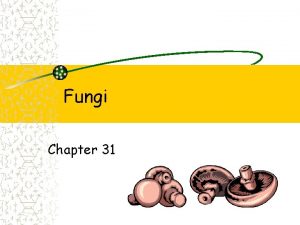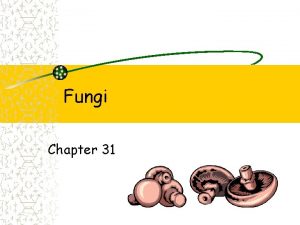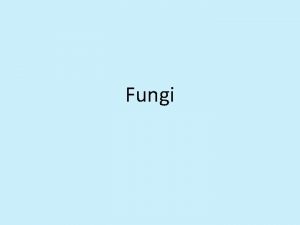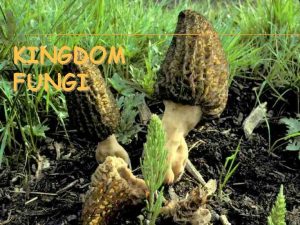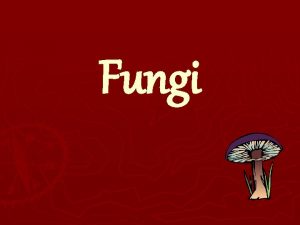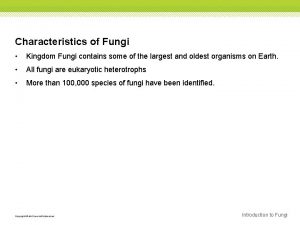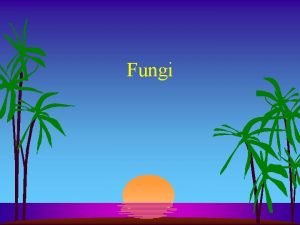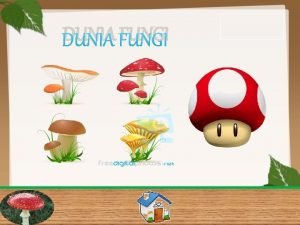Fungi Characteristics Fungi are everywhere Some fungi are

















- Slides: 17

Fungi

Characteristics • Fungi are everywhere. • Some fungi are harmful, some are beneficial. • Fungi include yeasts, molds, and fleshy fungi (e. g. , mushrooms). • They are the “garbage disposers” of nature.

Characteristics • Fungal cell walls contain a polysaccharide called chitin. • Some are unicellular, others grow as filaments called hyphae. – Hyphae intertwine to form a mycelium. • Some fungi have septate hyphae • Some fungi have aseptate hyphae • aseptate or septate hyphae is an important clue to its identification.

Reproduction • Fungal cells can reproduce by budding, hyphal extension, or the formation of spores. – There are 2 general categories of spores: • Sexual spores • Asexual spores (also called conidia) – Some fungi produce both. • Fungal spores are very resistant structures.

Classification • Is based primarily on their mode of sexual reproduction and the type of sexual spore they produce. • The 5 phyla of fungi are: Zygomycotina, Chytridiomycotina, Ascomycotina, Basidiomycotina, and Deuteromycotina. • Deuteromycotina or Deuteromycetes include the medically important moulds such as Aspergillus and Penicillium. – Fungi in this phylum have no mode of sexual reproduction or the mode of sexual reproduction is not known.

Aspergillus fumigatus Penicillium sp. Aspergilus flavus Curvularia sp. Scopulariopsis sp. Copyright © 2011 Wolters Kluwer Health | Lippincott Williams & Wilkins Histoplasma capsulatum

Yeasts • Lack mycelia. • Yeasts usually reproduce by budding, but occasionally by a type of spore formation. • A string of elongated buds is known as a pseudohypha (not really a hypha). • Some yeasts produce thick-walled, spore-like structures called chlamydospores (or chlamydoconidia).

Gram-Stained Clinical Specimen Containing Budding Yeast Cells

Microscopic Appearance of the Yeast Candida albicans A = Chlamydospores B = Pseudohyphae C = Budding yeast cells (blastospores) – Candida albicans is the yeast most frequently isolated from human clinical specimens

Fungi: Yeasts, cont. • Yeasts are found in soil and water and on the skins of many fruits and vegetables. – Yeasts have been used for centuries to make wine and beer. – Saccharomyces cerevisiae is a yeast used in baking.

Fungi: Yeasts, cont. • Yeast colonies may be difficult to distinguish from bacterial colonies when growing on media.

Gram-Stained Clinical Specimen Containing Yeasts, Bacteria, and White Blood Cells

Fungi: Molds • Molds produce hyphae. – – Aerial hyphae extend above the surface Vegetative hyphae grow beneath the surface. • Reproduction is by spore formation on the aerial hyphae (also known as reproductive hyphae).

Fungi: Molds, cont. • Molds have great commercial importance. – Some produce antibiotics. • Examples: Penicillium and Cephalosporium – Some molds are used to produce large quantities of enzymes that are used commercially. – The flavor of cheeses like bleu cheese, Roquefort, camembert, and limburger are due to moulds that grow in them.

Fungi Medical Significance • A variety of fungi are of medical, veterinary and agricultural importance because of the diseases they cause in humans, animals, and plants. • The infectious diseases of humans and animals that are caused by molds are called mycoses. • Fungal infections are categorized as superficial, cutaneous, subcutaneous, and systemic mycoses.

Dimorphic Fungi • A few fungi, including some pathogens, can live as either yeasts or molds • When grown at body temperature (37 o. C), dimorphic fungi grow as yeasts and produce yeast colonies. – When grown in vitro at room temperature (25 o. C), dimorphic fungi exist as molds, producing mold colonies.

Dimorphic Fungi, cont. • Dimorphic fungi that cause human diseases include: – Histoplasma capsulatum (histoplasmosis) – Sporothrix schenckii (sporotrichosis) – Coccidioides immitis (coccidioidomycosis) – Blastomyces dermatitidis (blastomycosis)
 Insidan region jh
Insidan region jh Logos everywhere
Logos everywhere Sometimes you win some sometimes you lose some
Sometimes you win some sometimes you lose some They say sometimes you win some
They say sometimes you win some Ice cream uncountable or countable
Ice cream uncountable or countable Contact and non contact forces
Contact and non contact forces Some say the world will end in fire some say in ice
Some say the world will end in fire some say in ice Some say the world will end in fire some say in ice
Some say the world will end in fire some say in ice Some may trust in horses
Some may trust in horses I've been everywhere canada
I've been everywhere canada Taoism philosophy
Taoism philosophy Security that fits everywhere
Security that fits everywhere Linux everywhere
Linux everywhere Sexism in schools uk
Sexism in schools uk Presentation about love and friendship
Presentation about love and friendship Clot retraction
Clot retraction Every learner everywhere
Every learner everywhere Slogan it's everywhere you want to be
Slogan it's everywhere you want to be



















